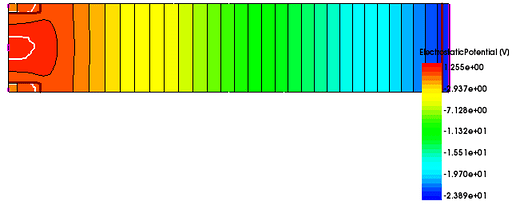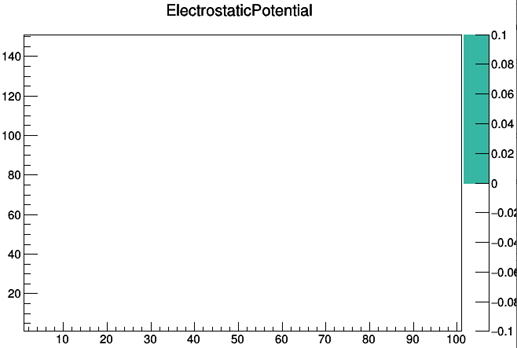Dear developers,
I report here an issue I encountered when converting TCAD Electrostatic potential maps from TDR files.
When I open in TCAD the Electrostatic potential map, I obtain the following map, which is not empty:
After this, I tried to convert it into an .init file by using the mesh_converter tool. The command line I used is:
./mesh_converter -c configuration.conf -f iv_50_1.2_-2_0.0_0.81_1px_allpix
And the configuration.conf file looks like this, which I hope is correct:
model = "init"
dimension = 3
region = "substrate"
observable = "ElectrostaticPotential"
divisions = 100 100 150
xyz = z x y
The output of the conversion contains a WARNING regarding the units (could this be a cause for the problem I’ll describe below?):
MacBook-Pro-di-Lorenzo:converted_mesh lorenzodecilladi$ ../../bin/mesh_converter -c configuration.conf -f iv_50_1.2_-2_0.0_0.81_1px_allpix
|10:55:50.313| **(STATUS)** Welcome to the Mesh Converter Tool of Allpix^2 v1.5.0+6^g3b9c7c98
|10:55:50.313| **(STATUS)** Using configuration.conf configuration file
|10:55:50.313| **(STATUS)** Reading mesh grid from grid file "iv_50_1.2_-2_0.0_0.81_1px_allpix.grd"
|10:55:51.046| **(INFO)** Parsing grid file: done.
|10:55:51.077| **(INFO)** Grid sizes for all regions:
|10:55:51.077| **(INFO)** Ntop1 85
|10:55:51.077| **(INFO)** Pbot 85
|10:55:51.077| **(INFO)** Ptop 68
|10:55:51.077| **(INFO)** substrate 7801
|10:55:51.077| **(STATUS)** Reading electric field from data file "iv_50_1.2_-2_0.0_0.81_1px_allpix.dat"
|10:55:51.205| **(INFO)** Parsing field data file: done.
|10:55:51.205| **(INFO)** Field sizes for all regions and observables:
|10:55:51.205| **(INFO)** substrate:
|10:55:51.205| **(INFO)** DopingConcentration 7801
|10:55:51.205| **(INFO)** ElectricField 7801
|10:55:51.205| **(INFO)** ElectrostaticPotential 7801
|10:55:51.205| **(INFO)** Using initial neighbor search radius of 0.1
|10:55:51.205| **(STATUS)** TCAD mesh (x,y,z) coords. transformation into: (z,x,y)
|10:55:51.205| **(STATUS)** Mesh dimensions: 50 x 10 x 50
New mesh element dimension: 0.5 x 0.1 x 0.333333 ==> Volume = 0.0166667
|10:55:51.205| **(INFO)** Reading the files took 0 seconds.
|10:55:51.206| **(STATUS)** Starting regular grid interpolation with 4 threads.
|12:01:50.585| **(INFO)** Interpolating new mesh: 9999 of 10000, 99%
|12:01:50.585| **(INFO)** New mesh created in 3960 seconds.
|12:01:50.624| **(WARNING)** No field units provided, writing field data in internal units.
|12:01:58.701| **(INFO)** Writing field data: finished.
|12:01:58.707| **(STATUS)** New mesh written to file "iv_50_1.2_-2_0.0_0.81_1px_allpix_ElectrostaticPotential.init"
|12:01:58.707| **(STATUS)** Interpolation and conversion completed in 3968 seconds.
MacBook-Pro-di-Lorenzo:converted_mesh lorenzodecilladi$
Unfortunately, the output init file looks empty (i.e. all the Electrostatic potential entries are empty; you can find the file here: https://cernbox.cern.ch/index.php/s/tox8pQD8Rhcg5ou).
If I plot the relative map with the mesh_plotter using the command
./mesh_plotter -f iv_50_1.2_-2_0.0_0.81_1px_allpix_ElectrostaticPotential.init
I obtain the following output (again with a WARNING) and the following empty map:
MacBook-Pro-di-Lorenzo:converted_mesh lorenzodecilladi$ ../mesh_plotter -f iv_50_1.2_-2_0.0_0.81_1px_allpix_ElectrostaticPotential.init
|12:04:55.929| **(STATUS)** Welcome to the Mesh Plotter Tool of Allpix^2 v1.5.0+6^g3b9c7c98
|12:04:55.929| **(STATUS)** Reading file: iv_50_1.2_-2_0.0_0.81_1px_allpix_ElectrostaticPotential.init
|12:04:55.929| **(WARNING)** No field units provided, interpreting field data in internal units, this might lead to unexpected results.
|12:04:57.287| **(INFO)** Reading field data: finished.
|12:04:57.287| **(STATUS)** Number of divisions in x/y/z: 100/100/150
Info in <TCanvas::Print>: png file iv_50_1.2_-2_0.0_0.81_1px_allpix_ElectrostaticPotential_yz_50.png has been created
MacBook-Pro-di-Lorenzo:converted_mesh lorenzodecilladi$
Am I doing something wrong? Or do you have any advice based on your experience?
Thank you for your kind support, I’m looking forward to contributing when I gain more experience with the Allpix-squared framework,
Best regards,
Lorenzo

